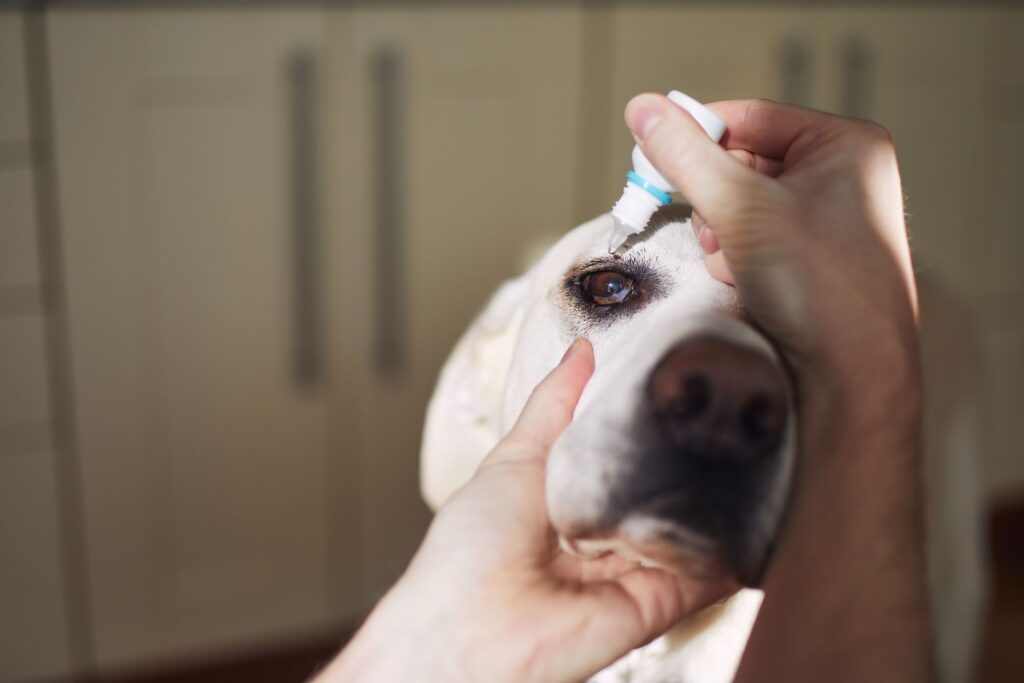Table of Contents
Dogs can suffer from many medical conditions that afflict humans. That includes pink eye.
Just like their human owners, dogs can develop pink eye at any point in their lives. The causes and symptoms tend to be nearly similar too.
Understanding the early warning symptoms of pink eye in dogs can help you act promptly and prevent the condition from causing lasting eye damage.
Read on for more insights into canine pink eye. The post will address the causes and symptoms of pink eye in dogs, as well as the possible treatments for the condition.
What Is Pink Eye?
Pink eye is the common name for conjunctivitis, a medical term for inflammation of the conjunctiva. The conjunctiva is the thin, transparent tissue lining the inside of your dog’s eyelids and the white portions of his eyes.
Pink eye causes serious inflammation of the blood vessels in your dog’s eyes. In other words, the animal’s eyes become bloodshot. This results in a red or pink color.
Types and Causes of Pink Eye in Dogs
The types of pink eye in dogs depend on the causes of the disease. The following are the main types of canine conjunctivitis;
1. Allergic Conjunctivitis
Allergic conjunctivitis results from allergic reactions to foreign substances (allergens) that enter and irritate your dog’s eyes. Common allergens include dust mites, pet dander, pollen, mold, drugs, and cosmetic substances like perfumes and shampoos.
Allergic conjunctivitis is usually seasonal and generally not contagious.
2. Bacterial Conjunctivitis
As the name implies, bacterial conjunctivitis occurs due to a bacterial infection. Common culprits include streptococcus and staphylococcus bacteria.
Contamination may result from physical contact with unclean objects or surfaces. This form of pink eye may be contagious or not.
3. Viral Conjunctivitis
Viral conjunctivitis is caused by a viral infection. The disease usually occurs alongside common cold infections in dogs.
If caused by a virus, pink eye can become highly contagious and may take close to one month to go away.
4. Traumatic Conjunctivitis
Pink eye in dogs might also result from direct physical injury to the conjunctiva. This form of the disease is known as traumatic conjunctivitis.
Examples of agents that may cause traumatic conjunctivitis include splinters, direct blow to the eyes, and larger pests like ticks.
5. Keratoconjunctivitis Sicca (KCS)
Last but not least, canine conjunctivitis could present as a medical condition called keratoconjunctivitis sicca (KCS).
Also known as canine dry eye, KCS impairs your dog’s natural ability to secrete tears. The disease usually presents a range of other complications, with pink eye being one of the main ones.
What Are The Symptoms Of Pink Eye In Dogs?
Pink eye symptoms may differ slightly depending on the type and cause. But in general, your pooch will exhibit the following signs;
• Red or pink-toned eyes
• Itchiness in the eyes, causing your dog to paw at the eyes incessantly or rub them against a surface
• Increased tearing
• A thick white, green, yellow, or clear discharge which builds up on the dog’s eyes, especially when asleep
• Inflammation or puffiness around the eyes
• Excessive squinting or blinking
• Eyelids that stick together
• Cold-like symptoms and upper respiratory infection (in the case of viral conjunctivitis)
• Dry eyes (in the case of keratoconjunctivitis sicca)
How Many Eyes Does Pink Eye Affect?
Conjunctivitis may affect one or both eyes. Again, this depends on the type and cause.
For instance, bacterial and traumatic conjunctivitis will only affect the eye that has been exposed to the bacteria or physical trauma. On the other hand, viral conjunctivitis typically affects both eyes.
Also, pink eye can start in one eye then spread to the other if the disease is contagious.
Another thing worth noting is that what appears to be pink eye could actually be a symptom of a more severe eye problem. That underscores the importance of contacting your veterinarian as soon as you notice significant changes in your dog’s eyes. The conventional wisdom is to schedule a visit to the vet at the first sign of eye issue.
Remember that pink eye will generally not go away on its own either. So, the sooner you act, the better for your pooch.
How Is Pink Eye Diagnosed In Dogs?
Physical examination is the primary method for diagnosing conjunctivitis in dogs.
Your veterinarian will look the dog up for any of the above-listed symptoms. The vet may administer an anesthetic eye drop to restore normal squinting and blinking. This makes physical eye examination less painful for the dog.
The vet will examine the eyes further for signs of physical trauma or foreign objects. In the meantime, they may also check for certain morphological and anatomical features that could act as risk factors. For instance, poor eyelid conformation may be a major risk factor for traumatic and allergic conjunctivitis in dogs.
Last but not least, the veterinarian will ascertain whether the dog is suffering from conjunctivitis as a primary or secondary condition. As we already indicated, this disease can occur alone or could be indicative of a deeper eye problem. Conditions like corneal ulcers, cancers, and macular degeneration could all predispose your pooch to pink eye.
What Are The Treatment Options?
There are numerous treatment plans for canine conjunctivitis. As you might have guessed by now, the treatments depend on the cause and type of disease involved.
Below are a few common treatment options for pink eye in dogs, depending on the disease type;
a) Allergic Conjunctivitis
• Antihistamines (usually in the form of oral or eye drops)
• Anti-inflammatory medications
• Cold compresses
• Artificial tears
• Steroid eye drops
b) Bacterial Conjunctivitis
• Antibiotics (including eye drops and ointments)
• Anti-inflammatory medications
• Cold compresses
• Artificial tears
• Steroid eye drops
c) Viral Conjunctivitis
• Cold compresses
• Artificial tears
• Steroid eye drops
d) Traumatic Conjunctivitis
• Cold compresses
• Anti-inflammatory medications
• Steroid eye drops
Is Surgery Ever An Option?
Surgery is usually not the immediate treatment option for canine conjunctivitis. However, your veterinarian could recommend surgery if your dog doesn’t respond to medication.
Severe forms of pink eye may also be addressed by a surgical operation. But in these cases, the surgery is usually prescribed alongside medications.
Can You Treat Pink Eye In Dogs Using Home Remedies?
It’s possible to treat pink eye in dogs using home remedies. However, it’s probably not a great idea. That’s because this disease affects the most sensitive organ in your dog’s face – the eyes.
Using the wrong home remedy or applying these compounds the wrong way could worsen corneal injury and might even lead to blindness. So, when it comes to treating pink eyes in dogs, your only option is to seek professional help.
Conclusion
Pink eye can easily become a serious problem for your dog if not addressed with the urgency it deserves. Therefore, always have your vet’s number on speed dial and contact them at the first onset of any conjunctivitis symptoms.
It’s also important to take proactive measures to minimize the risks of pink eye in dogs. That includes maintaining hygiene around your house and keeping your dog in his crate whenever you’re away or on a trip to reduce exposure to foreign materials.





